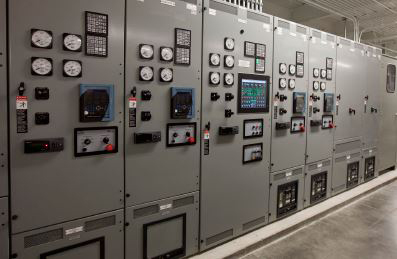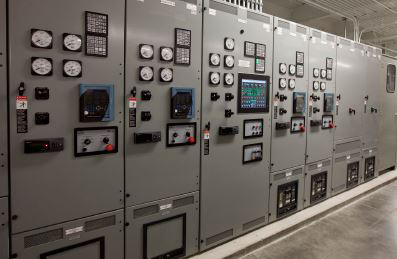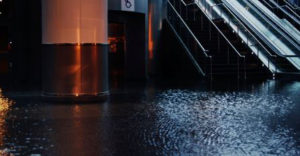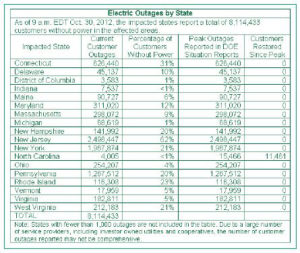
The impact of Hurricane Sandy gave U.S. power providers and code-making bodies a wake-up call
More than eight million utility customers lost electrical power as a result of Hurricane Sandy’s devastating impact, according to David Sandalow, acting undersecretary of energy, and assistant secretary for policy and international affairs. He described the storm’s damage during his presentation at the Columbia University Energy Symposium after Sandy slammed into the East Coast of the U.S.
“Sandy’s impact on energy infrastructure was especially devastating,” Sandalow said. “High winds took down power lines. Rising seas flooded electric substations. Within 24 hours of Sandy’s landfall, more than eight million utility customers lost power. Fuel distribution networks were paralyzed. Critical terminals for petroleum and petroleum products were badly damaged. Many service stations lost power and couldn’t pump gas, leading to long gasoline lines in the New York/New Jersey area.”
Historically, Bellevue Hospital Center has been at the top of the list to receive patients evacuated from other health care facilities when disasters—natural or not—struck. However, Bellevue, New York City’s flagship public hospital and the premier trauma center in Manhattan had to evacuate more than 300 patients due to loss of electrical power.
Although the emergency generators, which are located on the 13th floor, had been operational, fuel issues prevented their continued operation. According to The New York Times, the fuel pumps that feed the emergency generators are located in the basement at Bellevue, which was still flooded after pumping out 17 million gallons of water. Of course, water and electrical equipment such as fuel pumps for emergency generators don’t mix.
Codes & Disasters

Electrical equipment is the example of critical infrastructure that needs to be protected and properly located so it can provide service during emergencies. Keep it out of the basement or ensure its location is never affected in any man-made or natural disaster.
Why are facilities that must operate to provide services during disasters allowed to locate critical electrical system components in vulnerable areas? Although designs of this magnitude require a great deal of thought and planning, it’s difficult to include every possible scenario. Even codes and standards as extensive as they are can’t cover everything.
According to NFPA 110: Standard for Emergency and Standby Power Systems, 2013 edition, Annex A, paragraph A.7.2.4: “EPSS [emergency power supply system] equipment should be located above known previous flooding elevations where possible.”
Also, according to paragraph A.7.2.5, “For natural conditions, EPSS design should consider the ‘100-year storm’ flooding level or the flooding level predicted by the Sea, Lake, and Overland Surges from Hurricanes (SLOSH) models for a Class 4 hurricane.”
The preceding are suggestions from Annex A: Explanatory Material. They are not requirements. The body of NFPA 110 is less emphatic about flooding. In Chapter 7: Installation and Environmental Considerations, paragraph 7.2.4 states, “The rooms, enclosures, or separate buildings housing Level 1 or Level 2 EPSS equipment shall be designed and located to minimize damage from flooding, including that caused by the following:
- Flooding resulting from fire fighting
- Sewer water backup
- Other disasters or occurrences
Proper generator sizing is also critical
When generators are sized to accommodate the anticipated maximum simultaneous load, problems can occur when testing the generator using live connected load. Actual building load is often insufficient to load large generators beyond a small portion of the generator’s rated nameplate loading. This situation can cause wet stacking, a condition where unburned fuel condenses in the exhaust system. However, wet stacking can be avoided by sizing the generator closer to the anticipated running load and ensuring that the base load exceeds 40 percent of the generator’s capacity.
This creates a scenario where generators have less capacity when more capacity is desired. One solution to this situation is to use load banks to supplement the generator loading during testing. Another solution is to procure multiple smaller generators instead of using a single large unit. Although it requires more capital, this approach solves several issues: generator loading, power system redundancy, and power quality issues.
When using a single generator, motor starting currents, nonlinear loads, and various block loads can affect generator voltage, current, and frequency stability. However, operating multiple smaller generators on an aggregate bus arrangement is more likely to provide stable steady-state operation, better power quality, unit redundancy, spare generators if necessary, and it minimizes the chance that wet stacking will occur by solving the 40 percent loading issue.
Note that these flooding references appear in section 7.2.2: Outdoor EPS [emergency power supply] Installations. However, the previous section, 7.2.1: Indoor EPS Installations, doesn’t address flooding at all.
NFPA 99: Health Care Facilities Code, 2012 edition echoes and references the language in NFPA 110. However, NFPA 99 is more specific in its Annex B: Additional Explanatory Notes, paragraph B.12.3.2.4, “Flooding into a facility’s lower levels where utilities are often housed results in a disruption of these services.” Paragraph B.12.3.2.5 states: “Power is lost typically as a result of high winds and flooding. Generators and transfer switches have been lost due to their location below the high water mark.” Again, Annex B offers observations and suggestions—not requirements.
NFPA 70: National Electrical Code (NEC), 2011 edition Article 517 is explicit in defining division of a facility’s electrical according to applicability. It defines which loads are essential and which are nonessential. Of the essential electrical system, it defines the equipment system, critical branch, and life safety branch.
However, as with NFPA 110 and NFPA 99, the NEC does not address flooding in great detail. NEC Article 517.35 (C) states, “Careful consideration shall be given to the location of the spaces housing the components of the essential electrical system to minimize interruptions caused by natural forces common to the area (e.g., storms, floods, earthquakes, or hazards created by adjoining structures or activities).”
NEC Articles 700 and 701 address capacity for emergency systems and legally required standby systems respectively. “The sizing requirements of 700.4 and 701.4 say that emergency generators have to be able to handle all the loads, but do not apply to hospital generator sets,” said Tom Divine, senior engineer and project manager, Smith Seckman Reid Inc., Houston. “Hospital generators in particular can have the situation where they have to run for extended periods. For hospitals, you may size according to prudent demand factors and historical data.”
While natural disasters are mentioned in these codes, explicit requirements are not. “The codes are not terribly detailed,” Divine said. “They suggest placing generators with an eye toward a list of possible disasters. But they just give you a list and don’t tell you much. Every segment of the country has its own kind of disasters.”
Location, location, location
Do the codes go far enough to enable adequate emergency coverage? “I don’t think they go far enough,” said Ken Lovorn, president, Lovorn Engineering Assoc., Pittsburgh. “They talk about not putting life safety branch and critical branch wiring in the same raceway [517.30 (C) (1): Separation from Other Circuits]. But they don’t talk about having physical separation that’s distant enough to really prevent a simultaneous outage.”
NEC Article 517, paragraph 517.30 (C) (1) states, “The life safety branch and critical branch of the emergency system shall be kept entirely independent of all other wiring and equipment and shall not enter the same raceways, boxes, or cabinets with each other or other wiring.”

Flooding stops even basic features such as escalators. These are on the street level. Anything in the basement of this building is completely under water and useless.
According to Lovorn, there are some references about having the normal switchgear in the same room as the emergency generator. “But there’s nothing to prevent you from having the generator, switchgear, and the paralleling gear in the basement,” Lovorn said. “I don’t think they have enough. The industry needs more regulation, more codes.”
How should codes and standards change to ensure that electrical power—either from utilities or emergency generators—remains available to critical facilities during natural or manmade disasters? “The location of the electrical equipment should be addressed,” said Lovorn. “I have encountered many situations where facilities put the electrical switchgear in the lowest level and they get high water, a flood, or a pipe breaks. The electrical equipment ends up getting wet. And water and electricity are immiscible.”
Sandalow’s Columbia University presentation included similar admonitions. “In flood zones, critical electrical equipment such as breaker boxes and building connections should not be in basements or on ground floors,” Sandalow said. “This point may seem obvious, but this basic vulnerability is found in thousands of buildings in low-lying areas. Building codes in general do not address this. In the days and weeks following Hurricane Sandy, water damage to critical electric equipment dramatically slowed electric restoration in many locations.”
“We do a lot of thinking about disasters based on our experience here in Houston with Tropical Storm Allison,” Divine said.
Tropical Storm Allison hit in June 2001, dropping more than 40 inches of rain in Texas alone. The worst flooding occurred in Houston. Flooding inundated the city’s downtown area, severely damaging hospitals and businesses.
“I’ve never [personally] had to recover from a natural disaster,” said Divine. “I did do a project where we put 2 million square feet in a better situation to cope with a disaster, but it was after the recovery. We took a reference level of 47 feet above sea level as being the nominal flood plain. The medical center went to 48 and our hospital went to 49. Everybody pushed it a foot higher than the last guy.
“After we picked the nominal flood level, we looked for anything [electrical] that was below it that served something above it,” Divine said. “For example, the main service entrance was at about 16 feet. That’s 30 feet deep in water if the 47-foot nominal flood level is reached. We elevated that service entrance to 49 feet. We elevated the second service entrance from 30 feet to 68 feet. We tried to get above what we saw as the 500-year flood plain. Allison defined that flood plain because it had never been seen before. We relocated anything that was below the flood plain. We built new service entrances and then disconnected portions of the hospital and reconnected them to the new service entrances.”
Lovorn has encountered similar situations. Typically, natural gas engines are used to operate natural gas compressor stations. “In this particular compressor station, they decided to put in an electrically-driven gas compressor,” Lovorn said. “I went to look at the site and discovered a stream running beside the compressor station. When I learned that the plan was to locate the electrical equipment at the compressor station floor level, I told them it was a really bad idea. I said, ‘There are no codes that say that I should do or should not do what you’re asking me to do. But I think it’s really poor design, and I suggest that we elevate the level of the electrical equipment to at least the level of the adjacent road.’
“Within two years of the installation of being completed I got a call from the electrical contractor. He said that the water was up to within 6 inches of the floor of the platform for the electrical equipment. If we had put it down where they wanted to, they would have had four feet of water in the electrical gear.”
NFPA 110, Annex A, paragraph A.7.2.4 states, “EPSS equipment should be located above known previous flooding elevations where possible.” Again, this is a suggestion, not a requirement.
Capacity matters

How should codes and standards change to ensure that electrical power—either from utilities or emergency generators—remains available to critical facilities during natural or manmade disasters?
While the topic of health care facilities quickly comes to mind when disasters strike, other types of facilities such as police stations, fire stations, emergency management centers, emergency call centers, and government facilities involved in national security are also important to public safety and well being.
First appearing in the 2008 edition of the NEC, Article 708: Critical Operations Power Systems (COPS) are defined in Article 708.2 as “power systems for facilities or parts of facilities that require continuous operation for the reasons of public safety, emergency management, national security, or business continuity.”
Article 708.1, Informational Note No. 1 states, “Critical operations power systems are generally installed in vital infrastructure facilities that, if destroyed or incapacitated, would disrupt national security, the economy, public health or safety; and where enhanced electrical infrastructure for continuity of operation has been deemed necessary by governmental authority.”
The local Authority Having Jurisdiction has the authority to require a designated area—or all of a facility—to comply with 708. If only a designated area, as opposed to the entire facility, is required to comply with 708, that area is labeled Designated Critical Operations Area (DCOA).

Source: U.S. Department of Energy, Office of Electricity Delivery & Energy Reliability, Hurricane Sandy Situation Report # 4, Oct. 30, 2012 (10 a.m. EDT);
Data centers, telecommunications installations, weather radar systems, and even banking and financial systems are included within the scope of Article 708. These services glue our modern society together. And while 708 provides a higher level of protection for these mission critical facilities and services, does it go far enough to ensure capacity?
Article 708.22 (A) states, “A COPS shall have capacity and rating for all loads to be operated simultaneously for continuous operation with variable load for an unlimited number of hours, except for required maintenance of the power source. A portable, temporary, or redundant alternate power source shall be available for use whenever the COPS power source is out of service for maintenance or repair.”
However, 708.22 (B) allows the emergency power source to supply COPS emergency, legally required standby, and optional loads where the source has adequate capacity or where automatic selective load pickup and load shedding is provided as needed to ensure adequate power to (in order of priority):
- COPS and emergency circuits
- Legally required standby circuits
- Optional standby circuits
Data center owners and hospital managers may see the emergency power capacity issue as a glass that’s either half full or half empty. While some may feel that emergency power must accommodate every load in the facility—even during extended outages, attitudes tend to change when capital funds are sought. However, many data center owners pop for the capital for generating capacity to keep their facilities alive. One reason for this disparity is that data centers have a narrow range of loads—computers, routers, servers, and the HVAC to keep them cool. On the other hand, health care facility loads are extremely diverse, necessitating division and prioritization of loads.
NEC also addresses the duration of COPS operation. Article 708.22 (C) states, “(C) Duration of COPS Operation. The alternate power source shall be capable of operating the COPS for a minimum of 72 hours at full load of DCOA with a steady-state voltage.”
Note that the power source capacity must be capable of handing the full DCOA load, regardless of whether that designated area is a portion of a facility or the entire facility. Also note that the 72 duration is a minimum, with no mention of a maximum. Finally, the steady-state voltage must be regulated to within ±10% of nominal utilization voltage regardless of load.
Telecommunications is another area protected by Article 708. Data centers must be operational to provide availability. However, operational does not guarantee availability. During Hurricane Sandy, some telecommunications carriers maintained service, while others did not. What was the difference? NEC Article 708 offers the same protection.
Keeping fuel flowing
NFPA 110, Annex A, recommendations for Long-Term Fuels storage
The following text is from NFPA 110, Annex A, paragraph A.7.9.1.2. While this information makes recommendations based on industry best practices, it does not stipulate specific requirements.
To optimize the long-term storage of fuels for prime movers, the fuel tanks should be kept cool and dry, and the tank as full as possible. Tanks that are subject to temperature variations can experience accelerated fuel degradation, especially if the tanks are outside and above ground or close to an extreme heat source if stored inside a structure. The more constant and cooler the tank temperatures, the less likely temperature-related fuel degradation will occur.
Tank ullage (air space) should be kept to a minimum. Excess air space allows for warm, humid air to enter the tank and condense moisture during the cool evening. Also, prolonged exposure to ambient air, which is 20 percent oxygen, can facilitate oxidative degradation of the fuel.
Fuel storage tanks should be kept as dry as possible and have provisions for water drainage on a regular basis. The presence of water can lead to microbiological contamination and growth, which in turn can lead to general or pitting corrosion of steel tanks and components, possibly resulting in filter plugging, operational issues, or a hydrocarbon release to the environment.
Regularly scheduled surveillance of the fuel allows the operator(s) to evaluate the condition of the fuel and make important decisions regarding the quality of the fuel dedicated to reliable operation of the prime mover. Fuel maintenance and testing should begin the day of installation and first fill in order to establish a benchmark guideline for future comparison. Laboratory testing services should always be sought from a qualified or certified petroleum laboratory.
Hurricane Sandy also significantly damaged the region’s fuel distribution infrastructure. “With regard to fuel distribution, the Northeast might look to the Gulf Coast for some lessons,” said Sandalow. “After Hurricane Katrina, refineries and other pieces of fuel infrastructure were hardened. Some power lines were put underground; backup generators were positioned; in some places, fuel infrastructure was elevated or barriers erected. Several years later, when Hurricane Ike approached, fuel storage tanks and pumping trucks were pre-positioned in key locations and priority was given to restoring power to fuel infrastructure.”
“One of the problems with diesel generators: you have to count on them for an extended outage,” said Divine, “but you can’t always count on the availability of diesel fuel and deliveries.”
Referring to the codes, Lovorn said they “need to have something in place so diesel fuel for emergency generators can be replaced in a timely fashion—even if you have a disaster like Sandy.”
But how much fuel is enough fuel? In an article titled “Keeping gen set fuel flowing during disasters,” Robert M. Menuet, GHT Limited, Arlington, Va. wrote, “Identifying the amount of fuel needed to power your critical equipment during a reasonably predictable natural catastrophe is the first step. A rough consumption calculation for diesel generators is 7 gallons of fuel per hour for each 100 kW of generator rating; i.e., a 200 kW generator would consume 14 gallons of diesel fuel per hour.
A typical goal for on-site storage is three days’ worth of fuel. A site requiring a 2 MW generator installation should have approximately 10,000 gallons of available stored fuel to provide a three-day supply.”
NFPA 110 Annex A suggests from 48- to 96-hours as a minimum fuel capacity for emergency generators. It also offers suggestions for long-term fuel storage (see “NFPA 110, Annex A, recommendations for long-term fuels storage”).
Conclusion
In addition to hospitals and other health care facilities, Hurricane Sandy affected data centers, fuel providers, emergency agencies, and other critical entities. To prevent these vulnerabilities, code making bodies and authorities having jurisdiction must work more closely to ensure the public is protected and served. While much of the necessary language exists, there is really no widespread infrastructure to coordinate their execution.
In 2001, our primary customers completely changed their minds about what readiness means,” said Divine. “We all changed our minds about what a lot of water means.”
“Hurricane Sandy was yet another reminder that disaster response is a complex undertaking that requires sustained partnerships engaging federal, state, and local agencies, the private sector and civil society, academia, and even community clubs and religious groups,” said Sandalow. “Our work together must begin long before disaster strikes. There is always room for improvement, and Sandy has illustrated ways our energy systems are still vulnerable to disruption.”
